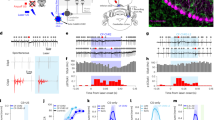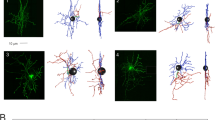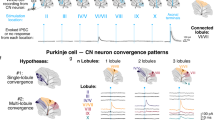Abstract
THE cerebellum is interesting for the arrangement of its neurones in a symmetrical three-dimensional lattice, with only two classes of input fibres and one of output fibres1. This arrangement led Braitenberg2 to postulate a set of logic operations that the cerebellar cortex might perform. One postulate was that, by virtue of the distribution of the “output” neurones (Purkinje cells) at regularly spaced intervals along beams of parallel fibres (Fig. 1A), the cerebellum might function as a type of clock, transforming an event that occurred at some peripheral spatial location into a temporal event. A central assumption of this hypothesis is that the time of firing of a Purkinje cell is determined by the conduction time of afferent impulses travelling in parallel fibres from some reference point on the beam of parallel fibres on which it lies to the Purkinje cell. If this assumption is correct the parallel fibre–Purkinje cell system would constitute a tapped delay-line2–4. If the reference point is the position of another Purkinje cell along the beam, then a corollary is that the time between the firing of the two cells must be equal to the conduction time of the segment of the beam connecting them.
This is a preview of subscription content, access via your institution
Access options
Subscribe to this journal
Receive 51 print issues and online access
$199.00 per year
only $3.90 per issue
Buy this article
- Purchase on SpringerLink
- Instant access to full article PDF
Prices may be subject to local taxes which are calculated during checkout
Similar content being viewed by others
References
Ramony Cajal, S., Histologie du Système Nerveux de l'Homme et des Vertébrés, 2 (Al Maloine, Paris, 1911).
Braitenberg, V., Nature, 190, 539 (1961).
Bell, C. C., and Griman, R. J., J. Neurophysiol., 23, 1044 (1969).
Freeman, J. A., Neurobiology of Cerebellar Evolution and Development (edit. by Llinas, R.) (AMA/ERF, Chicago, 1969).
Eccles, J. C., Ito, M., and Szentagothai, J., The Cerebellum as a Neuronal Machine (Springer, New York, 1967).
Eccles, J. C., Llinas, R., and Sasaki, K., Exp. Brain Res., 1, 17 (1966).
Llinas, R., and Bloedel, J., Science, 155, 601 (1967).
Perkel, D. H., Gerstein, G. L., and Moore, G., Biophys. J., 7, 419 (1967).
Freeman, J. A., and Stone, J., in Neurobiology of Cerebellar Evolution and Development (edit. by Llinas, R.) (AMA/ERF, Chicgo, 1969).
Author information
Authors and Affiliations
Rights and permissions
About this article
Cite this article
FREEMAN, J., NICHOLSON, C. Space–Time Transformation in the Frog Cerebellum through an Intrinsic Tapped Delay-line. Nature 226, 640–642 (1970). https://doi.org/10.1038/226640a0
Received:
Issue date:
DOI: https://doi.org/10.1038/226640a0
This article is cited by
-
Synergy temporal sequences and topography in the spinal cord: evidence for a traveling wave in frog locomotion
Brain Structure and Function (2016)
-
Cross-correlation analysis of unit activity in spinal locomotor centers
Neurophysiology (1981)
-
Mathematical analysis of the possibility of detecting correlation between spike trains of weakly interacting neurons
Neurophysiology (1981)
-
Timing of bilateral cerebellar output evoked by unilateral vestibular stimulation in the frog
Pfl�gers Archiv European Journal of Physiology (1979)



